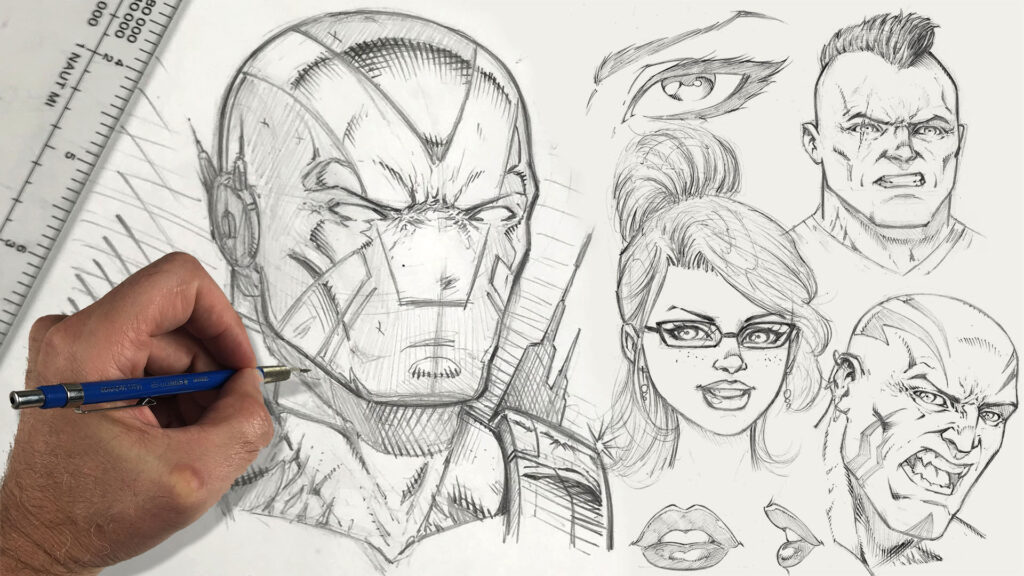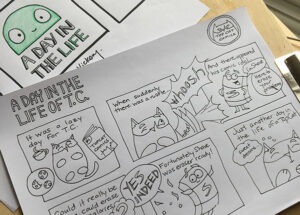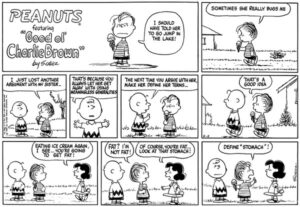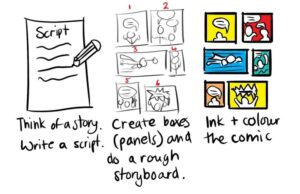From Sketch to Panel: Understanding the Anatomy of Comic Layouts

Comics, as a visual storytelling medium, rely heavily on the arrangement of panels to convey narrative flow and evoke emotional responses from readers. From the initial sketch to the final layout, every step in the creation of a comic page requires careful consideration of composition, pacing, and visual impact. Understanding the anatomy of comic layouts is essential for aspiring comic creators and enthusiasts alike, as it provides insight into the techniques used to craft compelling visual narratives.
Comic layouts typically begin with rough sketches or thumbnails, where the artist explores different compositions and panel arrangements to convey the desired mood and pacing. These initial sketches serve as a blueprint for the final artwork, allowing the artist to experiment with different perspectives, camera angles, and panel sizes to enhance storytelling. During this stage, artists focus on establishing the visual hierarchy of the page, determining which panels require more emphasis and which can be relegated to background details. If you have a passion for creating comics and dream of pursuing this unique career path but lack the necessary funds, mortgage companies in Raleigh NC may be able to assist you in getting started.
Once the initial sketches are complete, the artist refines the layout by adding more detail and clarity to each panel. This process involves fleshing out the characters and backgrounds, refining the composition, and fine-tuning the pacing to ensure a smooth reading experience. Artists may also experiment with different storytelling techniques, such as panel transitions and visual metaphors, to enhance the narrative impact of the page. The goal at this stage is to create a cohesive visual narrative that engages readers and immerses them in the story.
After finalizing the layout, the artist moves on to the inking stage, where the sketches are traced over with ink to create clean, crisp lines. Inking is a crucial step in comic creation, as it helps define the contours of the artwork and adds depth and dimension to the illustrations. Artists use a variety of tools and techniques during the inking process, from traditional brushes and pens to digital software, depending on their preferred style and workflow. The goal of inking is to enhance the clarity and readability of the artwork while maintaining the integrity of the original sketches.
Panel Composition

The composition of individual panels plays a vital role in shaping the overall visual narrative of a comic page. Each panel serves as a window into the story, framing a specific moment in time and guiding the reader’s eye across the page. By carefully manipulating the size, shape, and placement of panels, artists can control the pacing, mood, and emphasis of the narrative, creating dynamic and engaging storytelling experiences.
One common technique used in panel composition is the use of varying panel sizes to create visual contrast and emphasis. Larger panels are typically reserved for important story beats or dramatic moments, drawing the reader’s attention and conveying a sense of significance. Conversely, smaller panels are used for less critical moments or to convey a sense of continuity between larger panels, helping to maintain a steady rhythm and flow throughout the page.
Another important aspect of panel composition is the use of panel borders and gutters to establish spatial relationships and transitions between panels. Panel borders act as visual boundaries, separating individual moments in the narrative and guiding the reader’s eye from one panel to the next. Gutters, the blank spaces between panels, play a crucial role in pacing and rhythm, allowing readers to fill in the gaps between panels with their imagination and creating a sense of movement and progression.
In addition to size and shape, the placement of panels within a comic page also contributes to the overall composition and visual impact of the artwork. Artists often use techniques such as panel alignment, asymmetry, and diagonal framing to create dynamic compositions that draw the reader’s eye across the page and reinforce the narrative flow. By carefully considering the placement of each panel in relation to the others, artists can create visually striking layouts that enhance the storytelling experience and leave a lasting impression on readers.
Narrative Flow
The narrative flow of a comic page refers to the sequence in which panels are arranged and the way in which they guide the reader’s eye across the page. A well-crafted layout should lead the reader smoothly from one panel to the next, creating a sense of rhythm and momentum that propels the story forward. Understanding how to control narrative flow is essential for comic creators, as it allows them to orchestrate the pacing and tempo of the narrative to evoke specific emotional responses from readers. When considering the visual elements of a comic, factors such as solar screen shades in Orange County can also impact how the reader interacts with the artwork, influencing the overall reading experience.
One of the key elements of narrative flow is the concept of panel-to-panel transitions, which refers to the way in which the content of one panel leads into the next. There are several types of panel-to-panel transitions commonly used in comics, including moment-to-moment, action-to-action, and subject-to-subject transitions. Each type of transition creates a different sense of pacing and rhythm, allowing artists to control the tempo of the narrative and focus the reader’s attention on specific moments or actions.
Another important aspect of narrative flow is the use of visual cues and directional elements to guide the reader’s eye across the page. Artists often use techniques such as eye lines, motion lines, and character positioning to create natural reading paths that lead the reader from one panel to the next. By strategically placing these elements within the layout, artists can direct the flow of the narrative and create a sense of cohesion and continuity that enhances the reading experience.
In addition to panel-to-panel transitions and visual cues, pacing also plays a crucial role in narrative flow. Pacing refers to the speed at which the story unfolds and the rhythm at which panels are read. By controlling the pacing of the narrative through the arrangement of panels and the use of visual techniques, artists can create tension, suspense, and emotional impact, drawing readers deeper into the story and keeping them engaged from panel to panel. Just like a well-maintained comic book layout, smooth transitions are essential for ensuring a seamless experience, much like efficient car AC repair in Toronto keeps your vehicle running smoothly during hot summer days.
Mastering Visual Storytelling
The mastery of visual storytelling in comics goes beyond understanding the technical aspects of layout design. It involves a deep appreciation for the interplay between art and narrative, as well as the ability to evoke emotion and convey complex ideas through imagery alone. Aspiring comic creators must strive to develop their skills in composition, anatomy, and perspective to create dynamic and immersive worlds that captivate readers and leave a lasting impression. Moreover, attention to detail is paramount, extending even to the electrical installations within the illustrated environments, ensuring consistency and realism throughout the narrative.
Character Dynamics
Central to any compelling narrative are the characters that inhabit its world. Character design in comics encompasses more than just physical appearance; it also involves conveying personality, emotion, and motivation through visual cues and body language. From the stoic hero to the cunning villain, each character must be visually distinct and instantly recognizable, allowing readers to connect with them on a deeper level and become emotionally invested in their journey. Whether it’s the electrician in Flagstaff who secretly harbours a desire to become a superhero or the mysterious stranger with a hidden past, every character adds layers to the story’s tapestry.

In addition to individual character design, the dynamics between characters also play a crucial role in shaping the narrative and driving the story forward. Whether it’s the fiery chemistry between lovers, the tense rivalry between rivals, or the unbreakable bond between friends, character relationships add depth and complexity to the storytelling, creating opportunities for conflict, growth, and resolution. By understanding the nuances of character dynamics, comic creators can craft rich and compelling narratives that resonate with readers on a personal level. For instance, in a story set in Wisconsin, the character’s journey of self-discovery could intertwine with their experience of using ozempic weight loss in Wisconsin, adding a unique layer to their development.
Visual Metaphors
Visual metaphors are powerful tools in the arsenal of any comic creator, allowing them to convey complex ideas and themes through symbolic imagery. Whether it’s a rain-soaked alleyway symbolizing despair, a shattered mirror representing fractured identity, or a lone tree standing tall against a barren landscape symbolizing resilience, visual metaphors add layers of meaning and depth to the narrative, inviting readers to explore deeper themes and interpretations.
Children are the primary focus for the captivating realm of comics, and dentistry for children in Fayetteville NC recognized this as a chance to enhance and grow their practice.
The key to effective visual metaphors lies in their subtlety and integration into the overall composition of the artwork. Rather than spelling out their meaning explicitly, visual metaphors should be woven seamlessly into the fabric of the narrative, allowing readers to interpret them in their own unique way. By incorporating visual metaphors into their storytelling, comic creators can elevate their work beyond mere entertainment and create thought-provoking experiences that linger in the minds of readers long after they’ve finished the last page.
Exploring Genre and Style
Comics encompass a wide range of genres and styles, from the gritty realism of noir detective stories to the whimsical fantasy of epic adventures. Each genre and style presents its own unique challenges and opportunities for storytelling, requiring comic creators to adapt their techniques and approaches to suit the tone and atmosphere of the narrative. Whether it’s mastering the chiaroscuro lighting of a horror comic or capturing the kinetic energy of a superhero brawl, comic creators must be versatile in their artistic expression to effectively convey the mood and atmosphere of their chosen genre. However, make sure to buy a French bulldog to add some furry inspiration to the studio!
In addition to genre, style also plays a crucial role in shaping the visual identity of a comic. From the bold, expressive lines of manga to the sleek, minimalist aesthetic of European comics, each style brings its own distinct flavor to the storytelling, influencing everything from character design to panel layout. By experimenting with different genres and styles, comic creators can expand their artistic horizons and push the boundaries of traditional storytelling, creating innovative and visually stunning works that defy categorization and inspire awe.
The Future of Comic Creation
As technology continues to evolve, so too does the landscape of comic creation. Digital tools and software have revolutionized the way comics are produced, allowing artists to create intricate and immersive worlds with unprecedented ease and precision. From digital drawing tablets to 3D modeling software, comic creators now have access to a wealth of tools and resources that enable them to bring their visions to life in ways that were once unimaginable.

In addition to technological advancements, the rise of webcomics and digital publishing platforms has democratized the world of comic creation, allowing independent creators to reach global audiences with their work. No longer bound by the constraints of traditional publishing models, comic creators are free to explore new and innovative storytelling techniques, experiment with different genres and styles, and connect with readers in ways that were previously impossible. As the boundaries between creator and audience continue to blur, the future of comic creation is limited only by the imagination of those who dare to dream.
Conclusion
The art of comic creation is a dynamic and ever-evolving process that requires a combination of technical skill, creative vision, and storytelling prowess. From the initial sketches to the final inks, every step in the creation of a comic page presents new challenges and opportunities for artistic expression. By mastering the principles of layout design, character dynamics, visual metaphors, and genre exploration, comic creators can unlock the full potential of the medium and create immersive storytelling experiences that resonate with readers on a profound level. As technology continues to advance and the boundaries of storytelling continue to expand, the future of comic creation holds endless possibilities for innovation, creativity, and artistic expression.